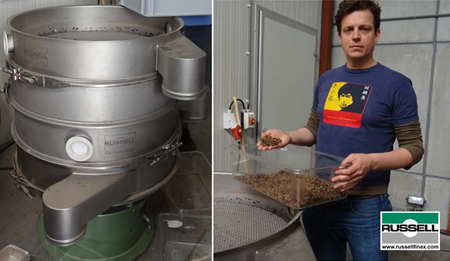Gyratory Round Sieve For Insect Larvae
Organic food waste is converted into reusable material with the help of eco vibratory separator

Tons of organic waste such as fruit and vegetables are thrown away by the retail sector every day. Johan Jacobs, Founder and Fly Master of Millibeter, sought to address this issue with a natural process, reducing organic waste while generating sustainable raw materials.
Founded in 2012, Millibeter breeds the Hermetia illucens (Black Soldier Fly) to feed on organic waste. This fly was chosen as it only eats during the larvae stage, preventing the spread of diseases and bacteria. In addition, the larvae consists of chitin, fat and protein, making it suitable for use in many agricultural, industrial, pharmaceutical and chemical processes.
Breeding and production process
A few days after the Hermetia illucens flies have bred, they lay eggs which hatch after two days. These hatched larvae are then fed organic waste, mainly unsold fruit and vegetables collected from supermarkets or farmers. The larvae will eat up to three times their weight, and with 5 million larvae being processed at one time, up to 500kg of organic waste is consumed every day. Once the larvae have grown to 1.5cm, they are sieved and processed before they pupate, and are then packed and supplied for research projects or to be processed in industrial applications such as the production of detergent, soap and lotions, or biodiesel.
The sieving process consists of the larvae being screened into four fractions. The first fraction contains the grown larvae which are ready to be packed, while the second fraction consists of smaller larvae which still need to be fed to grow larger. The third and fourth fractions are remaining organic waste and oversize waste such as stones and twigs.
Millibeter initially used a manual process to sieve the larvae, which proved to be labor-intensive and a bottleneck in the production process. With the introduction of the pilot plant, the company sought a new, more efficient solution.
Screening solution
Millibeter took the option of trialling the equipment at the manufacturer’s headquarters and their own production site. Jacobs comments “We were very satisfied with the service Russell Finex offered us. By trialling the machine at both the Russell Finex facility and at our site we were confident that the machine was the right one for the job.” Subsequently, the company purchased a 30” Russell Eco Separator®.
This is a high-performance gyratory sifter, commonly used for agricultural or environmental applications to grade wet or dry materials, able to accurately grade up to five fractions of material in one operation.
With the installation of the Russell Eco Separator®, Millibeter has been able to upscale production, now able to process up to 40 tons of organic waste a day. Jacobs states, “With the Russell Eco Separator installed not only have we been able to upscale our production to the capacity we need, but we have also saved a lot of time which had previously been spent on the manual screening process. Russell Finex has helped us achieve our mission to increase the amount of renewable resources generated from the tons of organic waste which would otherwise end up in landfill”. Millibeter is now able to grow approximately one million larvae a week, and hopes to upscale production even further soon.
Gyratory separator for food waste: http://www.russellfinex.com/en/case-studies/grading-insect-larvae-at-millibeter/
Russell Eco Separator: http://www.russellfinex.com/en/separation-equipment/sieving-machines/gyratory-sifters/
Russell Finex equipment trials: http://www.russellfinex.com/en/demonstration-videos/
CONTACT
Martin Chipperfield
Russell Finex Ltd
marketing@russellfinex.com
www.russellfinex.com
+44 20 8818 2000
Monday 15 May 2017 / file under Agriculture | Chemical | Engineering | Machinery | Pharmaceuticals


